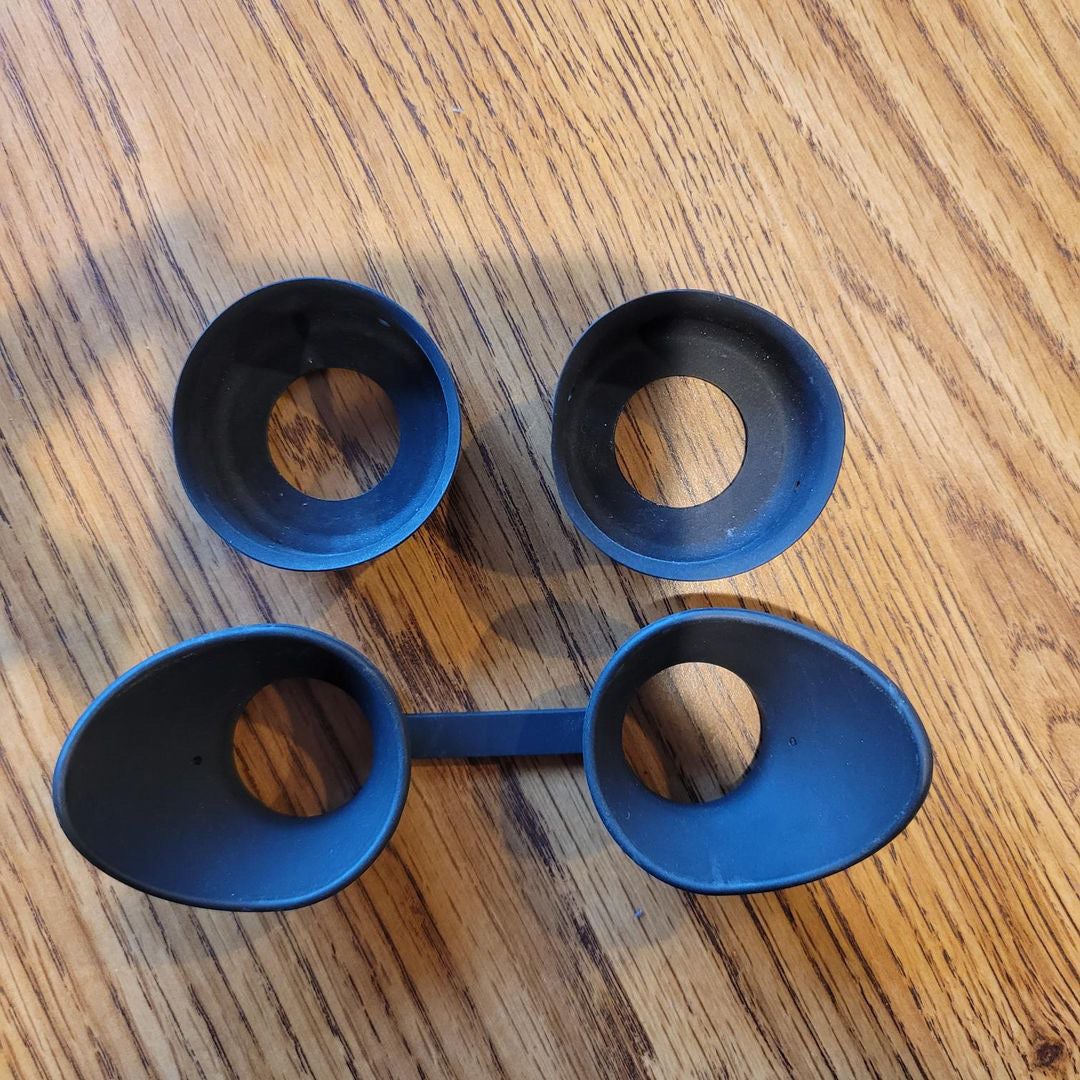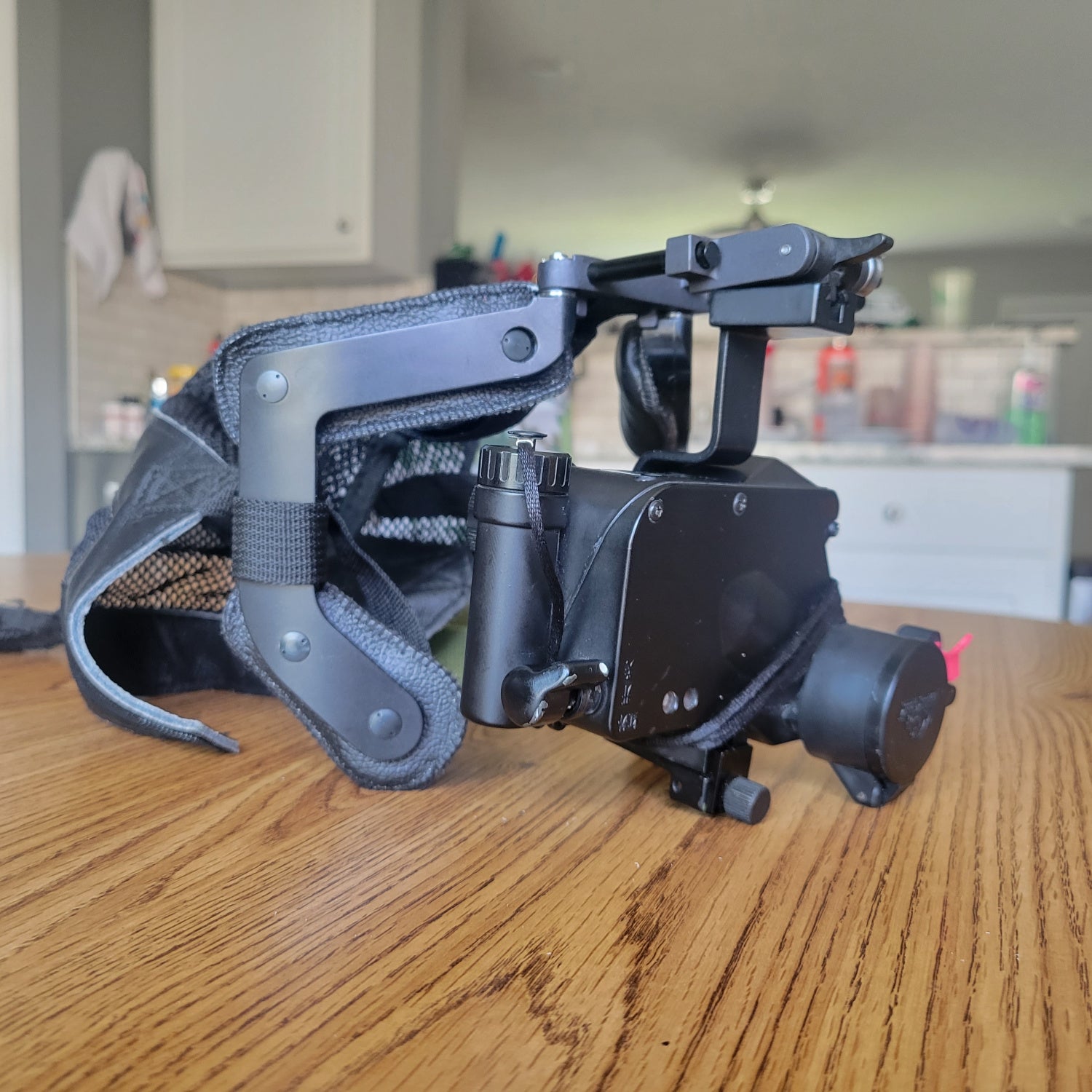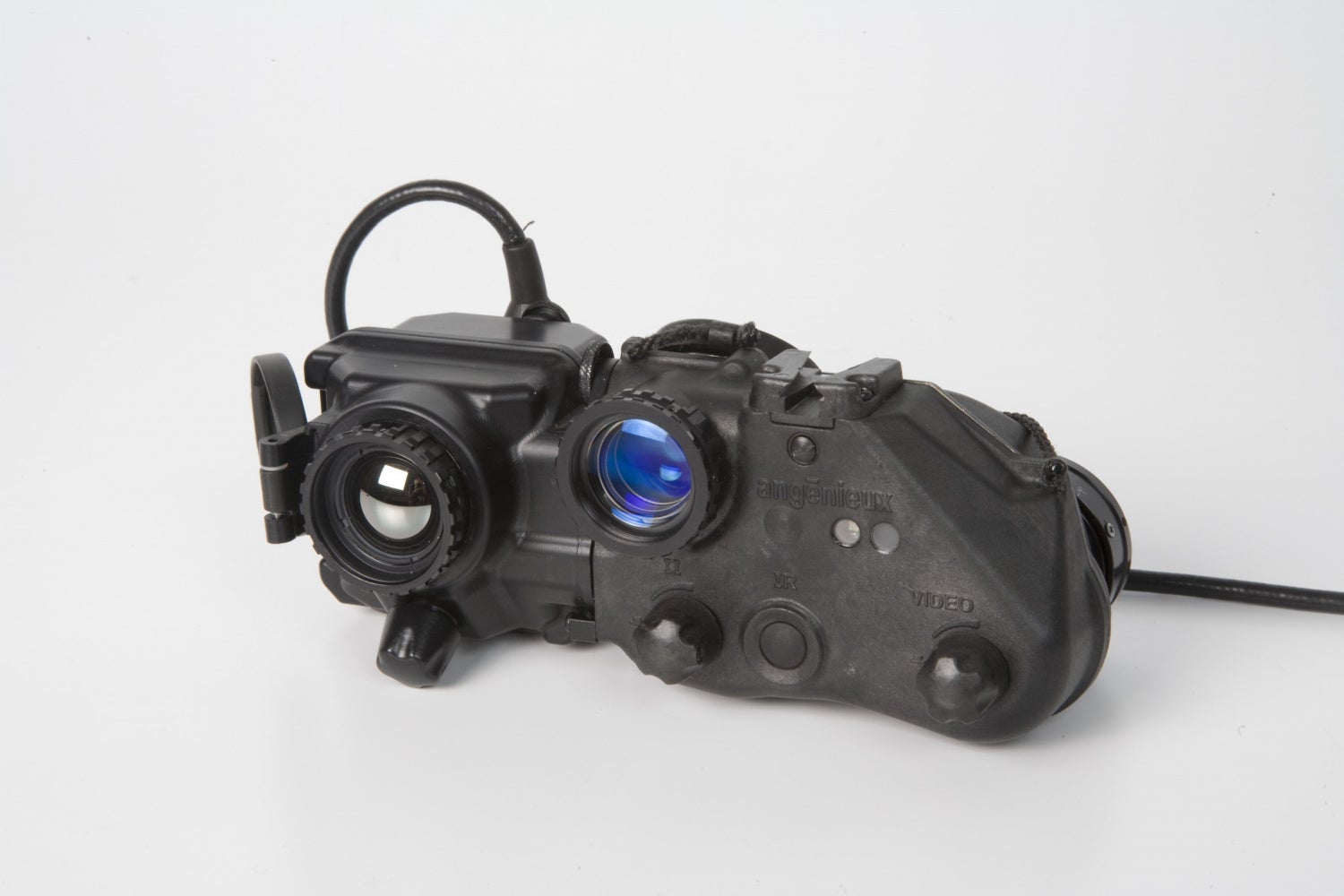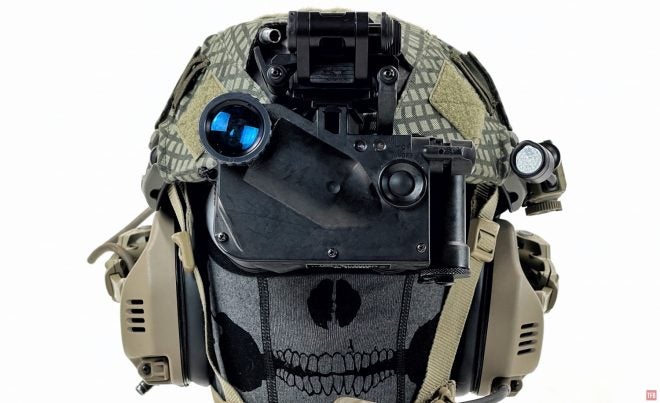Hello there fellow night vision enthusiast. If you have been following along, last week I showcased the monocular pod adapters for the AB Night Vision RPNVG. If you have been following me, you might know that I have been lusting for a Thales LUCIE for some time now. Well, I have one now and am happy to share this interesting low-profile night vision goggle (LPNVG) from France.
LPNVGs @ TFB:
- Friday Night Lights: Norwegian SIMRAD GN1 – Biocular NVGs
- Friday Night Lights: Sopelem TN2 – GIGN Night Vision Goggle
- Friday Night Lights: LPNVM PVS-21 A Steiner Tactical Monocle
- Friday Night Lights: Foreign Night Vision
Thales LUCIE LPNVG

Photo credit: Soldier Systems Daily
The photo above is what sparked my interest in the Thales LUCIE (LUnette Compacte Intensifiée Economique). It was allegedly a photo of a GIGN officer. Some commenters in the Solider Systems Daily post claim it was a promotional photo for MSA and their Gallet TC800 helmet. The Thales LUCIE is also issued to the German Bundeswehr. Regardless, I dig it and had to have one. Here is the LUCIE next to my other LPNVG, the Simrad GN1. I thought the GN1 was small, well, the LUCIE is smaller.



The LUCIE is not a binocular NVG but a biocular. Similar to a PVS-7 it has a single 10130 image intensifier tube and like a Simrad GN1, it is oriented sideways to keep the goggle low profile. The tube sits diagonally in the housing and projects the image into a beam splitter. So it shows up in both ocular lenses. Your eyes will see the same image so you will not get stereopsis (depth perception).

The LUCIE has all the same features a PVS-14 does. It has a daylight objective lens cover that is tethered to the housing.



The objective lens has a cutout in the outer ring and it indexes off a rectangular protrusion in the housing. This is your infinite and close focus stop.


On the left side of the housing is the on switch. It has a slight protrusion in the track to prevent accidental activation. Almost like a stick shift gate pattern. Once on, you can press the rubber circular button for momentary activation of the IR illuminator. Next to the illuminator is a bright light cutoff. If you want constant activation of the IR illuminator, you need to press the on switch inwards and rotate it up.


Just behind the on switch is the battery compartment. It is powered by a single AA battery for a run time of 45 hours. Just like the lens cap, the battery cap is tethered to the housing.

As I mentioned earlier, the Thales LUCIE is a biocular. It has two ocular eyepieces but a single tube. Unlike the PVS-7, the Lucie does not have an adjustable pupillary distance. It is fixed, similar to the Simrad GN1. This is due to the beam splitter design. It is like an inverted “y”. Moving the eyepieces left and right would require the beam splitter to have to physically change shape.

The eyepieces do have individually adjustable diopters.

On top of the housing is a proprietary dovetail shoe unlike the US which uses dovetails or bayonet horns.

Wearing The LUCIE On Your Face

The Thales LUCIE comes with a proprietary skull crusher. As far as skull crushers go, this one is one of the best.

The skull crusher has a mask that presses up against your face to hold up the LUCIE NVG. Due to the low profile nature of the LUCIE, there is not much pressure on your forehead.

The mount allows the LUCIE to flip up out of the way.



On the left side of the mount is a magnet. It controls the goggle so when you flip it up, the goggle will turn off. Flip it back down and the magnet will turn the goggle back on.

The mount itself does not flip. Rather the dovetail and latch are what flip 180º.

You can see the dovetail and shoe below.


What makes the Thales skull crusher one of the best is that the face mask/pads can fold inwards to make the entire headset smaller. You can see the arms below have stops so they cannot close tighter. They can only swing forwards for storage.

Looking top down, you can see the face pads at a fixed angle.

Here is what they look like when you fold the pads forward.

The skull crusher allows you to wear the goggles under a hood.

Helmet Mounting The Thales LUCIE

Thales makes a strap-on mount for helmets but I do not have one of those. This one only came with the skull crusher. However, there are aftermarket mounting solutions. Wilcox makes the G29 LUCIE mount so you can mount the goggle to a helmet with an NVG shroud.

The G29 mount comes with a dovetail adapter so you have a normal Wilxoc style dovetail on the LUCIE goggle.

You install the triangular insert into the molded dovetail shoe.


Then you place the Wilcox dovetail on top and bolt it down.






The G29 mount is designed to work with the LUCIE. A G24 mount can work but part of the mount touches the top of the goggle housing which can cause the dovetail to not entirely lock up. Also, the G24 only folds 90º. The G29 mount folds up past vertical.
The G29 mount has an articulating magnet so if you want the magnetic activation you can have it.


Or fold the magnet up out of the way and the goggle will not turn off when you flip the mount up.


Just above the magnet is the release button to fold the mount up and the tilt adjustment knob next to it. The skull crusher does not have any tilt adjustment.

On the other side is a rectangular tab. You have to pull the tab down to unlock it and then you can adjust the mount back and forth.

Can you use the PVS-21 Wilcox mount?
Yes, you can, but it is not ideal. At first glance, it seems like it could work.

However, it positions the LUCIE too low. Even with the mount adjusted as high as possible, it does not line up with the eyes. Another issue is the PVS-21 mount does not have tilt adjustment. The PVS-21 goggle has built-in tilt adjustment in the dovetail.

But you can flip the goggle 90º and past vertical.


Passive Aiming With The LUCIE
One issue I was concerned about is the ability to passively aim with the Thales goggle. The position of the objective lens is high and to the right of the user. It will work with optics on tall mounts like the GBRS Hydra. I did test a couple of guns with optics that sit too close to the face making them difficult to use with traditional night vision. First up is my G36 dual optic carry handle. It has a red dot on top of the 3X scope. I have it installed on my IWI X95.

It is not difficult to get the objective lens to look through the red dot.


Something else I tested with the Simrad GN1 was my FLUX raider. The brace positions my face too close for standard night vision to see through the red dot. But with the Thales LUCIE, I can aim passively.


Modifying The LUCIE
Since the Thales LUCIE is made in France, they come with Photonis tubes. The LUCIE uses 10130 tubes just like the PVS-7. If you recall, the SIMRAD GN1 uses 10160 tubes like in PVS-14s and binocular goggles.
So after checking that the Photonis tube functions, I swapped it out for my Elbit White Phosphor tube. While it works, I discovered there is a considerable amount of tint in the beam splitter. So the image projected out of the right ocular is shifted to look almost green. This defeats the purpose of installing a white phosphor tube. I ended up swapping the Elbit out for an Insight/L3 green phosphor tube so I can have gen 3 night vision in the LUCIE.
Accessories For The LUCIE

The new Argus NVG pouch perfectly fits the LUCIE in the accessories compartment in the lid while the skull crusher fits in the main compartment.
I also found this Thales pouch on eBay. It is for some sort of headset. The pouch has a waistband/belt while the main compartment fits the goggle perfectly.




I found the photos below on PrimePortal. They appear to be from a German Army display showcasing their gear. The helmet has a LUCIE goggle installed. You can see it has a lens cover that covers both ocular eyepieces.

Photo credit: Dieter Krause

Photo credit: Dieter Krause

Photo credit: Dieter Krause
Chinese LUCIE Clone
Thanks to Jacen Wu of Far East Tactical (@fareast_tactical) for sharing photos of his Chinese-made LUCIE clone.

Photo by @fareast_collective

Photo by @fareast_collective

Photo by @fareast_collective
The clone comes with two sets of eyecups. Two individual ones and a bikini-style set.

Photo by @fareast_collective
The markings for IR/ON/OFF are in Chinese.

Photo by @fareast_collective

Photo by @fareast_collective
He has a custom dovetail so he can use G24 style mounts with it.

Photo by @fareast_collective
Apparently, the Chinese even made an inverter mount. This reminds me of the one for the SIMRAD GN1. I believe this is so you can invert the LUCIE so the oculars are higher up and the goggle can fit under the brim of a helmet.

Photo by @fareast_collective

Photo by @fareast_collective
Final Thoughts On The Thales LUCIE
The LUCIE is a cool-looking night vision goggle. It was developed in the 90s and has a sci-fi aesthetic that I really like. It is not that heavy but they are not lightweight at around 438 grams or 15.4 ounces. That is close to a PVS-31A weight.
Thales designed the LUCIE to have 51º FOV compared to typical US night vision that have 40º FOV. The offset objective lens was only a minor issue when I tried driving my car at night. Since the objective lens is an inch or so above my eyes, my main rear view mirror required adjustment to see out the back. I did not notice much of an improvement with the 51º FOV but I did notice the lack of depth perception right away. I had to trust what my eyes saw but I felt a disconnect between where the car was with how far things are from it.
I like how small it is and since it uses PVS-7 style 10130 tubes, it is not difficult to swap the tubes out. One thing that is not great is the price. These are very rare and so fetch a high price. The last one I saw for sale, before acquiring this one, the seller was asking 4,000 euros for. I paid less than that but still more than I wanted to spend for a niche collectible. The Wilcox G29 mount costs $615 which is more than a G24. Sadly they do not sell the dovetail adapter on its own. One weakness of the LUCIE is the same as the PVS-7. The mounting interface is molded to the housing. If the dovetail shoe cracks, you cannot mount the goggle anymore.
I am glad to have the Thales LUCIE. But now I want the newer version, the MINIE or the MONIE monocular.

Photo by Thales. MONIE

Photo by Thales MINIE/D

Photo by Thales. MINIE
I would really like to check out a MINIE/D-IR with a thermal clip-on.

 Your Privacy Choices
Your Privacy Choices
